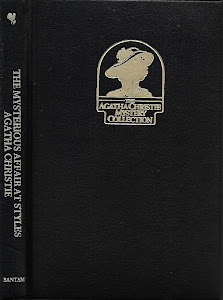
The Mysterious Affair at Styles by Agatha Christie is the first novel to feature Hercule Poirot. And, although Hastings has met the great detective in the past, this is apparently the first time that he has played Watson. Hastings is home on medical leave from the Great War and is invited by his old friend John Cavendish to spend his recovery time at the family's country home, Styles. Cavendish tells his friend, "I'm afraid you'll find it very quiet down here, Hastings." And Hastings assures him, "My dear fellow, that's just what I want." Unfortunately, it's not going to be quiet for long...
John's step-mother Emily Inglethorpe has recently been remarried to a much younger man. Alfred Inglethorpe has not been welcomed to the family bosom. The stepsons (John and Lawrence) don't think much of their step-papa, the servants all think Mrs. Inglethorpe has married beneath her, and even the man's own cousin, Mrs. Inglethorpe's beloved companion Evelyn Howard, believes he married Emily for her money. It isn't any surprise then that when Emily Inglethorpe dies of strychnine poisoning that suspicion immediately falls on Alfred.
In the meantime, Hastings has run across Poirot in the village. Poirot is one of several Belgian refugees from the war in Europe whom Mrs. Inglethorpe has helped to resettle. When tragedy strikes, Hastings convinces John to call upon the retired member of the Belgian police. The household is astonished when Poirot produces evidence of an alibi for Alfred and the hunt is on to discover who else might have had a motive to do away with the elderly lady.
This is not my first reading of Agatha Christie's first mystery novel. It is, however, the first time I have read it in over 30 years. And, I have to say, she did it again. Christie is one of the few detective novelists who can--if it has been long enough since I last read the book--manage to pull the wool over my eyes more than once. She is a master of misdirection and even in her debut novel, she is quite good at making the reader look at this when they really ought to be looking at that. Needless to say--I spent too much time looking at this. I am about as swift off the mark as Hastings.

It was quite enjoyable to go back to the beginning and start reading the novels again. My first reading of Christie was rather haphazard--I read whatever title came my way in whatever order I found them. I've now committed myself to a reread of her work in publication order. I am looking forward to seeing how her writing develops over time and which tropes she reuses (and how effectively each time). ★★★★
*****************
All Challenges Fulfilled: Mount TBR Challenge, Just the Facts, Calendar of Crime, Alphabet Soup Authors, Century of Books, World at War, Cloak & Dagger, Print Only, Strictly Print Challenge, Brit Crime Classics, Agatha Christie, Outdo Yourself, How Many Books, Six Shooter, Medical Examiner, PopSugar
My copy = no dust jacket
 Terror on the Titanic by Jim Wallace was a second Choose Your Own Adventure book to catch my eye when I was looking to find a title to read for the PopSugar Reading Challenge. I decided that rather than have to choose between the Tower of London and the Titanic I'd just bring both home and read them. This book plays a little more fast and loose with history than the Tower book did--sure it brought in ghosts, but the information it gave about the historical figures and the sections of the Tower were primarily factual. In this book, included among the options you have are those that allow you to save the Titanic and prevent one of the greatest steamship disasters in history. But, that's okay, the CYOA books are definitely more imaginative and fictional than the Chilling Interactive Adventure books--so we can give the author more poetic license.
Terror on the Titanic by Jim Wallace was a second Choose Your Own Adventure book to catch my eye when I was looking to find a title to read for the PopSugar Reading Challenge. I decided that rather than have to choose between the Tower of London and the Titanic I'd just bring both home and read them. This book plays a little more fast and loose with history than the Tower book did--sure it brought in ghosts, but the information it gave about the historical figures and the sections of the Tower were primarily factual. In this book, included among the options you have are those that allow you to save the Titanic and prevent one of the greatest steamship disasters in history. But, that's okay, the CYOA books are definitely more imaginative and fictional than the Chilling Interactive Adventure books--so we can give the author more poetic license. 






















